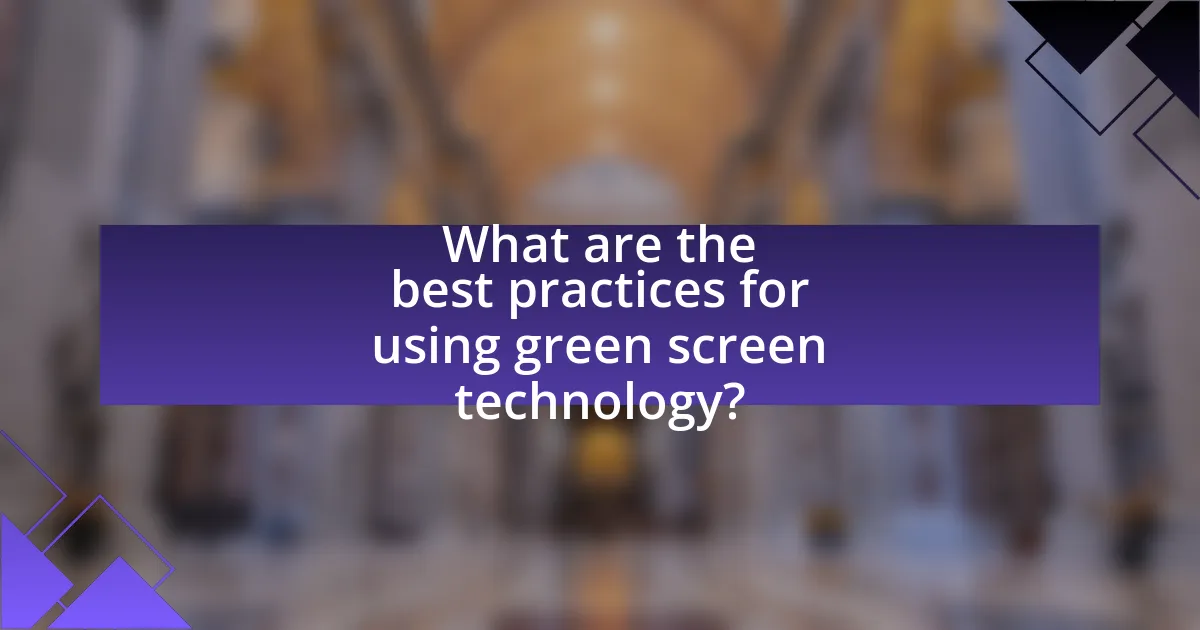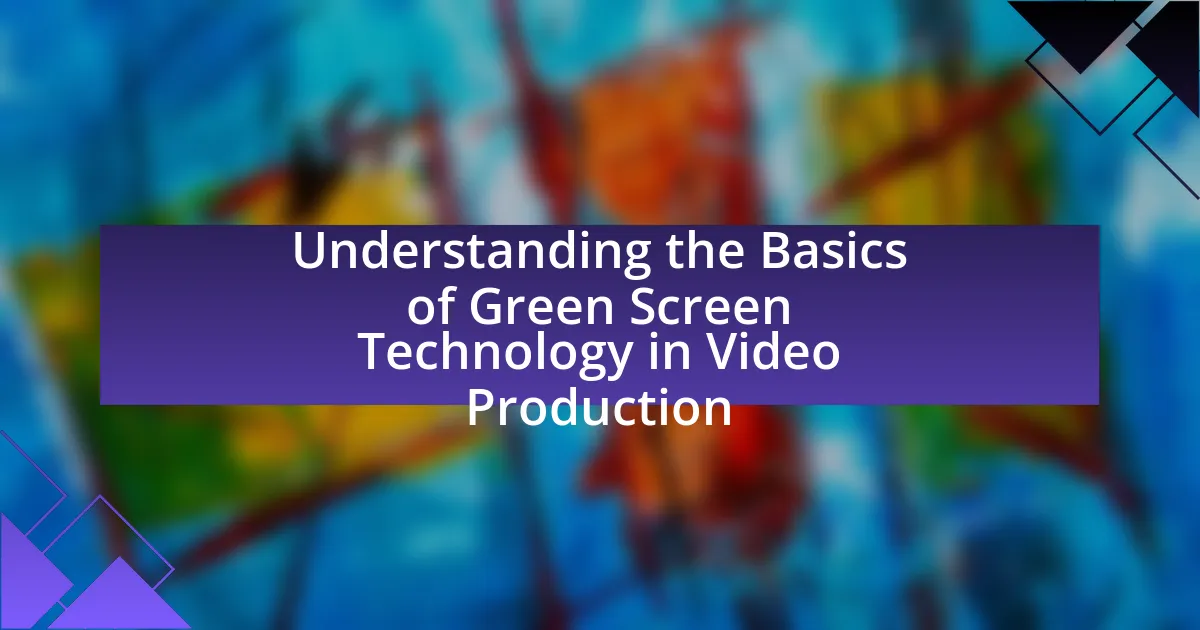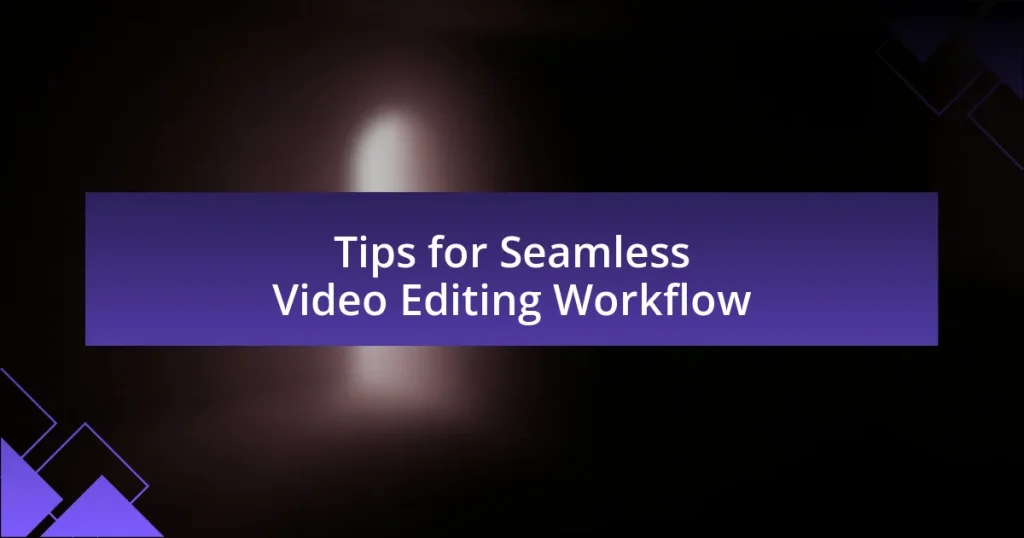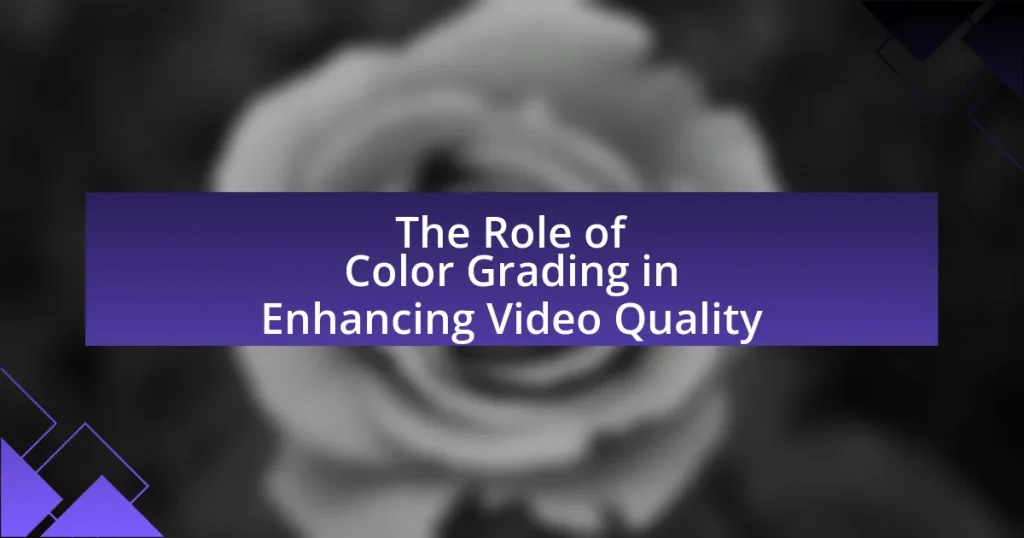Green screen technology is a visual effects technique widely used in video production that allows filmmakers to replace a solid color background, typically green, with different images or videos through chroma key compositing. This article provides an overview of how green screen technology works, including its key components, optimal color selection, and primary applications in film, television, live broadcasting, and video game development. It also addresses the benefits of using green screens, such as enhanced visual storytelling and cost reduction, while highlighting best practices, common challenges, and essential tools for effective implementation. Additionally, the article offers troubleshooting tips to ensure high-quality results in green screen video production.

What is Green Screen Technology in Video Production?
Green screen technology in video production is a visual effects technique that allows filmmakers to replace a solid color background, typically green, with a different image or video. This method works by using chroma key compositing, where the green color is digitally removed and replaced with desired visuals, enabling the integration of live-action footage with various backgrounds or effects. The effectiveness of green screen technology is evidenced by its widespread use in major film and television productions, such as in the creation of special effects in movies like “Avatar” and “The Avengers,” where complex environments are seamlessly blended with live performances.
How does green screen technology work in video production?
Green screen technology works in video production by allowing filmmakers to replace a solid color background, typically green, with a different image or video. This process, known as chroma keying, involves filming subjects in front of a green backdrop, which is then digitally removed in post-production using software that identifies and eliminates the green color. The effectiveness of this technique is due to the distinct color of the green screen, which is less likely to match skin tones or clothing, ensuring that only the desired subjects are retained in the final composition.
What are the key components of a green screen setup?
The key components of a green screen setup include the green backdrop, lighting, and camera equipment. The green backdrop serves as the primary element, providing a uniform color that can be easily keyed out in post-production. Proper lighting is essential to ensure even illumination on the green screen, minimizing shadows and reflections that can complicate the keying process. Camera equipment, including a high-resolution camera, captures the footage, ensuring that the quality is sufficient for effective chroma keying. These components work together to create a seamless integration of foreground subjects with virtual backgrounds in video production.
How is the green screen color chosen for optimal results?
The green screen color is chosen for optimal results primarily due to its distinct chroma key properties, which allow for effective separation of the subject from the background. Green is selected because it is the furthest color from human skin tones, minimizing the risk of keying out parts of the subject. Additionally, green screens reflect light well, making them easier to light evenly, which is crucial for achieving a clean key. Studies in video production have shown that using a color that contrasts sharply with the subject enhances the effectiveness of the chroma key process, ensuring that the background can be replaced seamlessly without artifacts.
What are the primary applications of green screen technology?
The primary applications of green screen technology include film and television production, live broadcasting, and video game development. In film and television, green screens allow for the seamless integration of actors with digital backgrounds, enabling the creation of complex visual effects and immersive environments. Live broadcasting utilizes green screens to replace backgrounds with graphics or other video feeds, enhancing viewer engagement. In video game development, green screens facilitate motion capture and the integration of real-world elements into virtual environments, improving realism and interactivity. These applications demonstrate the versatility and importance of green screen technology in modern media production.
How is green screen technology used in film and television?
Green screen technology is used in film and television to create composite images by replacing a solid color background with different visuals. This technique allows filmmakers to place actors in various environments that would be difficult or impossible to film in reality, such as outer space or fantastical landscapes. The process involves filming subjects against a green backdrop, which is then digitally removed in post-production using software like Adobe After Effects or Nuke. This method has been widely adopted since its popularization in films like “Star Wars” and “The Matrix,” demonstrating its effectiveness in enhancing storytelling and visual effects.
What role does green screen play in live streaming and virtual events?
Green screens play a crucial role in live streaming and virtual events by enabling the replacement of the background with digital images or video, thereby enhancing visual engagement. This technology allows content creators to transport themselves to various virtual environments, making the experience more immersive for viewers. For instance, during a live stream, a presenter can appear in front of a scenic landscape or a branded backdrop, which can significantly improve audience retention and interest. The effectiveness of green screens is supported by their widespread use in professional broadcasting and gaming, where they have become standard tools for creating dynamic and visually appealing content.

What are the benefits of using green screen technology?
Green screen technology offers significant benefits in video production, primarily enabling the seamless integration of different backgrounds and environments. This technique allows filmmakers to create visually compelling scenes without the constraints of physical locations, thereby enhancing creativity and storytelling. For instance, it is widely used in the film industry, as seen in major productions like “Avatar,” where green screens facilitated the creation of immersive, fantastical worlds. Additionally, green screens reduce production costs by minimizing the need for extensive location shoots and enabling the use of digital effects, which can be more efficient and flexible.
How does green screen technology enhance visual storytelling?
Green screen technology enhances visual storytelling by allowing filmmakers to create immersive environments that would be difficult or impossible to capture in real life. This technique enables the seamless integration of live-action footage with digitally created backgrounds, thereby expanding the narrative possibilities. For instance, films like “Avatar” and “The Avengers” utilize green screen technology to transport characters to fantastical worlds, enhancing the viewer’s experience and emotional engagement. The ability to manipulate backgrounds and settings in post-production not only saves time and resources but also fosters creativity, as filmmakers can visualize and realize complex scenes that align with their storytelling vision.
What creative possibilities does green screen technology offer?
Green screen technology offers a wide range of creative possibilities, primarily enabling filmmakers and content creators to place subjects in virtually any environment. This technology allows for the seamless integration of backgrounds, which can be anything from fantastical landscapes to historical settings, enhancing storytelling and visual appeal. For instance, films like “Avatar” and “The Matrix” utilized green screens to create immersive worlds that would be impossible to film in reality. Additionally, green screens facilitate the combination of live-action footage with animated elements, allowing for innovative visual effects that captivate audiences. The versatility of green screen technology is evidenced by its use in various media, including movies, television shows, and online content, demonstrating its significant impact on modern video production.
How can green screen technology reduce production costs?
Green screen technology can reduce production costs by minimizing the need for physical sets and locations. By using a green screen, filmmakers can create diverse backgrounds digitally, eliminating expenses related to travel, set construction, and location permits. For instance, a study by the American Film Institute found that productions utilizing green screens can save up to 30% on location-related costs. This technology allows for greater flexibility in post-production, enabling filmmakers to achieve high-quality visual effects without the financial burden of extensive on-site shooting.
What challenges are associated with green screen technology?
Green screen technology faces several challenges, including lighting issues, color spill, and the need for precise keying. Lighting inconsistencies can create shadows or uneven color, making it difficult to achieve a clean key. Color spill occurs when the green background reflects onto the subject, causing unwanted green hues in the final image. Additionally, achieving accurate keying requires careful attention to detail, as any imperfections can result in a poorly integrated background. These challenges necessitate meticulous planning and execution to ensure high-quality results in video production.
What common mistakes should be avoided when using green screens?
Common mistakes to avoid when using green screens include improper lighting, which can lead to uneven color and shadows, making it difficult to key out the background effectively. Additionally, wearing clothing that is similar to the green screen color can result in parts of the subject becoming transparent, causing visual issues. Another mistake is placing the subject too close to the green screen, which can create green spill on the subject, affecting the overall quality of the footage. Lastly, failing to use a high-quality green screen material can result in wrinkles and imperfections that complicate the keying process. These mistakes can significantly hinder the effectiveness of green screen technology in video production.
How can lighting affect the effectiveness of green screen technology?
Lighting significantly affects the effectiveness of green screen technology by ensuring even illumination and minimizing shadows on the green backdrop. Proper lighting reduces the risk of color spill, where green hues reflect onto the subject, which can complicate the keying process. For instance, using soft, diffused lighting helps achieve a uniform green surface, making it easier for software to distinguish between the subject and the background. Studies have shown that achieving a consistent light level across the green screen can improve keying accuracy by up to 90%, demonstrating the critical role of lighting in successful green screen applications.

What are the best practices for using green screen technology?
The best practices for using green screen technology include ensuring even lighting, maintaining a proper distance between the subject and the green screen, and using high-quality green screen material. Even lighting minimizes shadows and color variations, which can complicate the keying process. A distance of at least six feet between the subject and the green screen helps prevent green spill on the subject, which can interfere with the chroma key effect. High-quality green screen material, such as chroma key fabric or paint, provides a consistent color that enhances the effectiveness of the keying software. These practices are supported by industry standards, which emphasize the importance of lighting and distance in achieving professional results in video production.
How can one achieve the best results with green screen technology?
To achieve the best results with green screen technology, one must ensure proper lighting and even color distribution on the green backdrop. Adequate lighting minimizes shadows and highlights, which can interfere with the chroma keying process. Research indicates that using soft, diffused lighting helps create a uniform green surface, reducing the risk of color spill onto the subject. Additionally, maintaining a distance between the subject and the green screen prevents shadows and enhances the quality of the keying effect. Proper camera settings, such as using a high-quality camera and appropriate resolution, further contribute to achieving a clean key.
What tips can improve the quality of green screen footage?
To improve the quality of green screen footage, ensure even lighting across the green screen to eliminate shadows and hotspots. Proper lighting minimizes color spill and enhances the keying process, resulting in a cleaner composite. Additionally, use a high-quality green screen fabric that is wrinkle-free and non-reflective, as this reduces artifacts during post-production. Maintaining a sufficient distance between the subject and the green screen prevents green spill on the subject, which can complicate the keying process. These practices are supported by industry standards, which emphasize the importance of lighting and material quality in achieving professional results in video production.
How important is post-production in green screen video production?
Post-production is crucial in green screen video production as it enables the seamless integration of background elements with the foreground subject. This process involves key techniques such as chroma keying, where the green screen is removed and replaced with desired visuals, ensuring that the final product appears realistic and polished. According to industry standards, effective post-production can significantly enhance the visual quality and storytelling of a video, making it an essential phase in the production workflow.
What tools and software are essential for green screen production?
Essential tools and software for green screen production include a high-quality green screen backdrop, professional lighting equipment, and video editing software with chroma key capabilities. The green screen backdrop provides a uniform color for effective keying, while proper lighting minimizes shadows and enhances the quality of the footage. Software such as Adobe Premiere Pro, Final Cut Pro, or DaVinci Resolve offers advanced chroma key features that allow for precise background removal and integration of new backgrounds. These tools are critical for achieving professional results in green screen video production.
What are the best cameras for shooting green screen videos?
The best cameras for shooting green screen videos include the Canon EOS R5, Sony A7S III, and Panasonic Lumix GH5. These cameras are equipped with high-resolution sensors and advanced video capabilities, making them ideal for capturing detailed footage against a green screen backdrop. The Canon EOS R5 offers 8K video recording, which provides exceptional clarity and detail, essential for effective keying. The Sony A7S III excels in low-light conditions and features 4K recording at high frame rates, ensuring smooth motion capture. The Panasonic Lumix GH5 is known for its versatility and 4K video capabilities, making it a popular choice among content creators. These cameras are widely recognized in the industry for their performance in green screen applications.
Which software is recommended for editing green screen footage?
Adobe Premiere Pro is recommended for editing green screen footage. This software offers advanced chroma keying capabilities, allowing users to easily remove green backgrounds and replace them with other visuals. Additionally, Premiere Pro supports various formats and integrates well with other Adobe products, enhancing the editing workflow for video production. Its widespread use in the industry further validates its effectiveness for green screen editing.
What troubleshooting tips can help with green screen issues?
To resolve green screen issues, ensure proper lighting, as uneven or insufficient lighting can create shadows and inconsistencies. Additionally, check the distance between the subject and the green screen; maintaining at least three to six feet can help reduce shadows and color spill. Use a high-quality camera with appropriate settings to capture the green screen effectively, as lower resolutions can lead to poor keying results. Finally, utilize reliable software for chroma keying, as different programs have varying capabilities in handling green screen footage. These steps are essential for achieving a clean and professional-looking result in video production.



